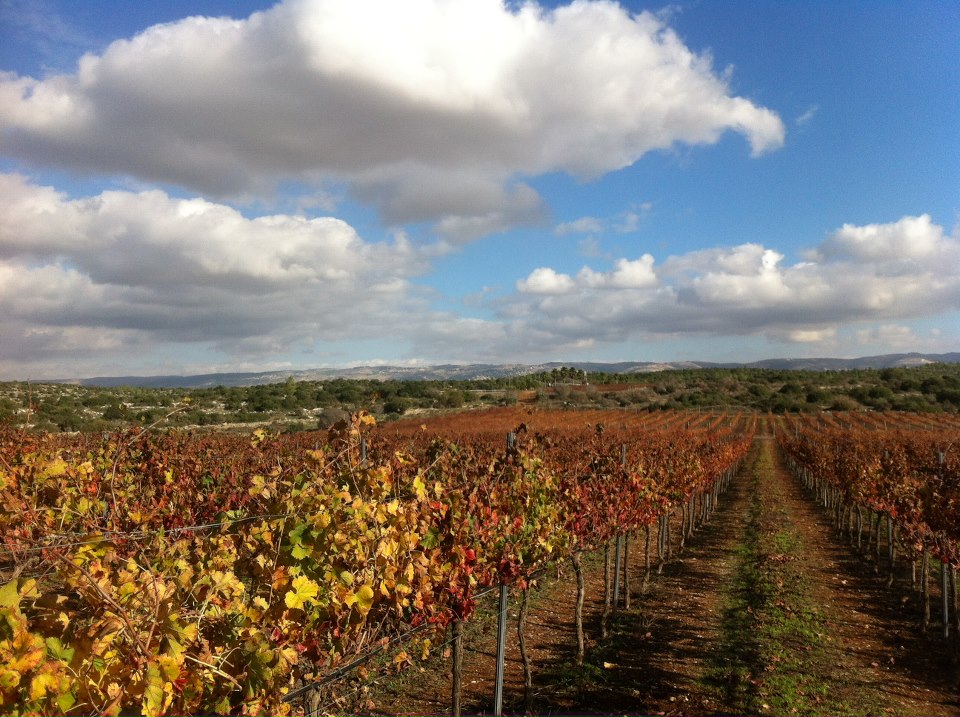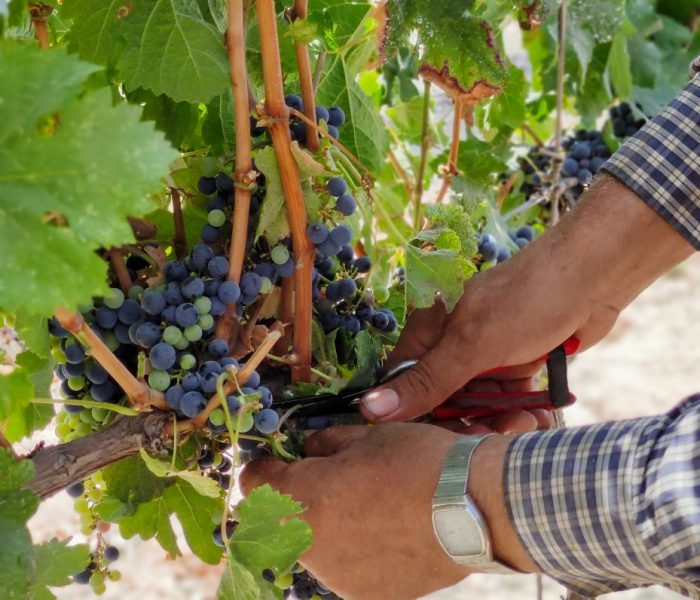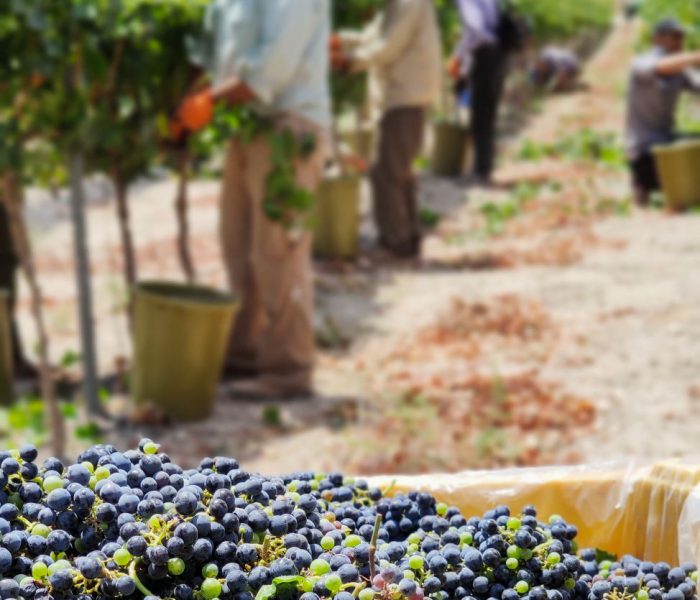Our Vineyards
Our Vineyards
These valley wineries are among the few wineries in Israel, on the order of 300,000 bottles a year, that have their own vineyards, which allows them to rely only on them without the need for external vineyards.
The winery owns 700 dunams.
Some of the vineyard’s produce is transferred to the winery and the rest is sold as raw material to other wineries.
The winery staff has selected the appropriate plots and the varieties to be planted in each plot, and is responsible for
the entire growing process and determining the harvesting moment.
Full control allows the winery to produce high quality and uniform wine, year after year.
Grapes are the raw material of the winery, and their quality determines the quality of the wine. Therefore, special attention and care is paid to the care of the vines.
The winery controls all the parameters that affect the vineyard – foliage, amount of water, soil, trailing, and more.
All of these affect the amount of crop, which is a very significant component in the quality of the grape: a crop that is too large impairs the intensity of the fruit and the characteristics of the variety, but even a crop that is too small is undesirable.
The secret is to find the right balance.
The vineyards are treated with methods that combine a long tradition brought from European and New World vineyards, and innovative technologies that ensure the quality of the grape.
A lot of effort is invested in preventing the penetration of harmful chemicals into the soil, through fertilization with natural materials such as compost and the use of advanced biological pesticides.
Three areas to grow wine
The Ella Valley was chosen after an extensive search. The area excels in aerated clayey soil, with good drainage and rich in minerals, and has a landscape diversity that allows different varieties to be grown in different habitats (terroir).
The climate is characterized by cool nights, humid and foggy mornings, and moderate heat even in the summer months, which are ideal conditions for the vine.
The winery owns three vineyard plots of approximately 800 dunams, each with its own unique landscape and land characteristics.
- Aderet vineyard
The largest vineyard (c. 400 dunams) planted at an altitude of 350-400 m in the Adullam hills, between Aderet, Givat Yeshayahu and Tzafririm.
Characterized by topographic diversity and soil with varying limestone content, creating ideal habitats for producing quality grapes, contributing to the health of the grape and the intensity of the fruit, and for achieving the classic characteristics of the variety and region.
Varieties: Cabernet Sauvignon, Merlot, Cabernet Franc, Syrah, Petit Syrah, Muscat and Chardonnay.
- Kerem Ness Harim
A vineyard of about 300 dunams at an altitude of 700 m, at the foot of Moshav Nes Harim in the Judean mountains.
Excels in deep soil with a clayey texture, high limestone content and low salinity. The height and ground are suitable for growing more pampered wine varieties.
Varieties: Cabernet Franc, Sauvignon Blanc, Chardonnay and Pinot Noir.
- Ella Valley Vineyard
The vineyard closest to the winery, is planted on an area of 100 dunams at a height of 320 m in the wadi at the edge of the Ella Valley. The location is characterized by a unique microclimate and offers excellent conditions for growing Syrah grapes.



The quality starts in the vineyard



The harvesting
Of great importance is the determination of the exact moment of the harvesting.
In the month prior to the planned date, a “ripening follow-up” begins, which includes a daily visit by the winemaker to each plot for testing in the field and taking fruit samples for chemical analysis in the laboratory.
Taking into account all the scientific tests, the final decision is based on the winemaker’s knowledge, experience, and personal feeling about the fruit’s readiness for harvest.
Grape selection
The secret of these valley wineries is in being able to decide on what to grow and how to grow, as well as set the moment of harvest and choose from the abundance of crop only the most suitable grapes.
Out of about 600 tons of grapes harvested each year, the winemaker selects only about a third for the winery’s needs. This is how the winery manages to produce accurate and balanced wines and ensure their quality.
Manual harvesting
The harvest is done manually and in a traditional method, to preserve the quality of the grapes.
These valley wineries are the only winery of a similar size, which adheres to manual harvesting in order to prevent any damage to the sensitive fruit.
The clusters are placed in small crates to maintain the integrity of the berry.
Nightly harvesting
The entire harvest is carried out during the cool night hours, to ensure that the fermentation process begins at the winery and under the winemaker’s control.
The short distance to the winery ensures that the clusters will be absorbed in containers in the early morning and enter the fermentation process in a noticeably short time.
Production process:
The harvesting
The harvesting is a critical stage in the wine production, so every detail in the process must be taken care of.
Determining the day of harvest, the time of harvest, the way it is done and the time that elapses until the grapes reach the winery.
The location of the winery was chosen due to its proximity to the growing areas, in order to allow for close monitoring and to shorten the time between harvest and arrival at the winery.
In these valley wineries, manual harvesting is carried out at night, to maintain the integrity and quality of the fruit.
The fermentation
The clusters of grapes arrive at the winery in the first reserve. After further manual sorting, the grapes are moved to the start of the fermentation process to the stainless-steel tanks.
The crop from each plot is absorbed in a separate container. The winery’s sophisticated fermentation tanks allow for the processing of varying quantities, close control and supervision of the process. Thus, in-depth knowledge of each plot and its unique properties is accumulated.
During the fermentation stage, the natural yeast on the grape float digests the sugar found in the grape must, and alcohol is produced from it.
The aging
At the end of the fermentation process, the wine is aged in wooden barrels, which lasts between 14 to 17 months.
Aging is carried out in ventilated and cool rooms and basements, with constant control of the temperature and humidity. Most of the winery’s wines are aged in French oak barrels, and a minority in American oak barrels with more pronounced wood flavors.
The winery uses wooden barrels from the second or third vintage, in order to avoid a dominant effect of the flavors of the wood, and to preserve the unique character of each variety and each plot.
This results in a wine in which the wood does not dominate the taste but only provides it with an additional layer that emphasizes and strengthens the regional berry flavors.
However, a certain amount from each part is aged in new barrels, to allow wood flavors to be added to the final blend, if necessary.
The blend
At the end of the aging process, the final blend begins, in which the winemaker makes a precise blend of the dozens of barrels, each with its own unique characteristics, to achieve the color, taste and aroma of the wine.
It is a personal and meticulous process that requires a lot of concentration and knowledge, combined with some alchemical magic.
At the end of the process, the unique taste of the wine is determined, which will continue to deepen and mature inside the bottle.
